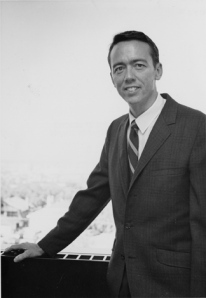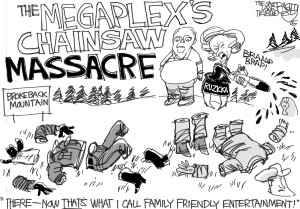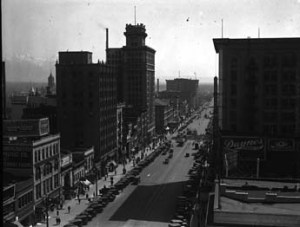by HANNA TATRO
Doug Fabrizio was born in 1964 in Bountiful, Utah. He studied at the University of Utah and began working and reporting for the KUER broadcasting station in 1987. KUER is a public radio station and is a member of National Public Radio (NPR). Its mission is simple: the station is “committed to building a community of world citizens through story and art, discussion and debate, sound and creativity.” (“About KUER”) The station is broadcast from the University of Utah and listeners around Utah tune in.
Fabrizio began working at the station when he was a junior in high school. By 1993, he had assumed the position of news director of KUER. (Sheehan) Then, in 2001, Fabrizio began hosting a radio segment, RadioWest. The show is “a radio conversation where people tell stories that explore the way the world works. (“About RadioWest“) In an interview with CityWeekly, Fabrizio expressed his views of the shows’ particular content, “Art and culture are an important part of the program. I actually don’t believe in segregating news – keeping the hard stuff from the softer stories (in fact I hate describing arts coverage or features as ‘soft’) or the local ones from the national ones. No matter where it comes from, most of us don’t see music or literature or great film as any less important to our lives than knowing about the critical events and issues of the day.” (Sheehan) Fabrizio has had the chance to interview many influential people throughout the years, from Madeleine Albright, the first woman in the United States to become secretary of state, to the Dalai Lama.

Doug Fabrizio became host and executive producer of KUER’s RadioWest in 2001. Photo courtesy of KUER.
Fabrizio’s work has been recognized by many organizations, including the Public Radio News Directors Association, Society of Professional Journalists, the Utah Broadcasters Association, and the Academy of Television Arts & Sciences.
RadioWest has steadily progressed throughout the years and Fabrizio’s style has evolved using storytelling mixed with honest interview question and answers. Fabrizio has profiled a number of topics, Utahns, and intellectuals, including the documentary, Ab Jenkins and the Boys of Bonneville, Everett Ruess, University of Utah President Chase Peterson, Congressman Ron Paul, David Foster Wallace, Nobel Peace Laureate Mohamed ElBaradei, and Robert Redford. These profiles incorporate Fabrizio’s storytelling approach.
“The Boys of Bonneville” segment aired on August 24, 2011. The segment featured the story of Ab Jenkins, who sped across the Bonneville Salt Flats and set record speeds. Fabrizio interviewed the director and others about the new documentary. Fabrizio introduced the piece with a simple introduction, setting the scene of the Salt Flats, a landmark not as well known by Utah residents as one would think. Fabrizio had four separate guests on the program; he kept the atmosphere relaxed.
Fabrizio focused on Everett Ruess, a young man who disappeared in the Utah desert, for a segment that aired on July 13, 2011. The tone was more serious as Fabrizio interviewed David Roberts, a writer who had thought he had found the body of Ruess. Fabrizio carried the piece by asking the tough questions first, and using basic interview skills. The piece doesn’t provide answers for where Ruess lies, but Fabrizio explores Ruess’s story and invites Roberts to discuss his chronicle of Ruess’ adventures.
University of Utah President Chase Peterson sat down with Fabrizio on May 7, 2012, to discuss his new book, The Guardian Poplar. The segment was carried by Fabrizio’s tone. He had respect for Peterson, which was evidenced by his very candid introduction. Fabrizio listed Peterson’s accomplishments and then let him do the talking. Peterson was humble and quiet and shared stories that appeared in his book. Fabrizio’s technique gave Peterson the stage and allowed the story to speak for itself. Peterson had been diagnosed with cancer and believed he only had a few years to live. But, he outlived his death sentence and Fabrizio’s presence put him at ease to share his struggles and joys.
Musician La Monte Young, who was born in Idaho and worked on a family farm on Utah Lake, has influenced some of the great artists. In a show that aired November 29, 2013, Fabrizio interviewed Professor Jeremy Grimshaw from Brigham Young University, who wrote a biography about the musical protégé. Fabrizio was knowledgeable about the guest and artist, but he asked open-ended questions that led to further discussion and allowed Grimshaw to discuss the complex character and Young’s musical compositions. Fabrizio’s technique allowed for a more in-depth approach that yielded untouched information.
Congressmen Ron Paul spoke at Utah Valley University in October 2012 and conducted a question and answer afterward with the students. Fabrizio’s segment took listeners inside the discussion and allowed people to share in the conversation. Fabrizio began with his simple introduction approach and allowed the congressmen to greet the viewers. Then Fabrizio facilitated the Q and A session.
David Foster Wallace was an acclaimed writer who committed suicide. D.T. Max, a New Yorker staff writer, wrote a biography of Wallace and joined Fabrizio’s show by phone to tell the story. The piece began with an introduction of Wallace and Max, which gave the audience an immediate feel for both parties.
Mohamed ElBaradei, a Nobel Peace Laureate, came to Utah in September 2012 to talk about his international atomic energy plans. He also joined Fabrizio for a RadioWest interview. The piece had a serious tone in keeping with a newsworthy international discussion.
Biographer Michael Feeney Callan chronicled the life of Robert Redford in his book, Robert Redford: The Biography. Callan spent fifteen years speaking to Redford and discovering his ways before finishing his book. Fabrizio introduced the September 2011 program with a story of Redford’s search for art and wanderings and then allowed Callan to discuss his book and findings about the infamous founder of Sundance Film Festival.
The early 1900s began the trend of the national radio craze throughout America. It all started with young teens from Utah, much like Fabrizio. In 1909 these kids began the first Radio Club in Salt Lake City. They transmitted and broadcast segments over the airwaves. (Larson and Avery) Fabrizio has continued to carry on the young Utah tradition and has transformed his broadcast to feature several storytelling techniques. He uses the airwaves to tell the stories, which carry communication to Utah and the rest of the nation.
Fabrizio’s broadcasts since 2009 can be found online. Archiving is an ongoing project.
Hanna Tatro graduated from The University of Utah in May 2014 with a Bachelor of Science degree in journalism.
Sources
Biographical sketch, Doug Fabrizio, RadioWest.
Doug Fabrizio, “Boys of Bonneville.” RadioWest.
Doug Fabrizio, “Finding Everett Ruess,” RadioWest.
Doug Fabrizio, “The Guardian Poplar,” RadioWest.
Doug Fabrizio, “The Music and Mysticism of La Monte Young,” RadioWest.
Doug Fabrizio, “Congressman Ron Paul,” RadioWest.
Doug Fabrizio, “The Life of David Foster Wallace,” RadioWest.
Doug Fabrizio, “Nobel Peace Laureate Mohamed Elbaradei,” RadioWest.
Doug Fabrizio, “Robert Redford: The Biography,” RadioWest.
Tim Larson and Robert K. Avery, “Utah Broadcasting History,” in Utah History Encyclopedia (Salt Lake City: University of Utah, 2009).
“About KUER,” KUER.org.
Gavin Sheehan, “Doug Fabrizio,” City Weekly, July 10, 2009.













